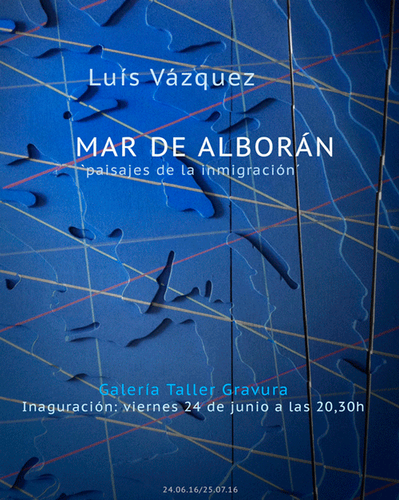ALBORAN SEA. The immigration landscapes – ( MAR DE ALBORÁN. Paisajes de la inmigración )

24.06.2016 / 25.07.2016
Gravura Workshop Gallery
Luis Vásquez’s exhibition at the Galería Taller Gravura in Málaga is only part and summary of a much broader and more complex work.
It all started during his vacation in Morocco a long time ago. The seductions of Africa instantly worked their magic on Louis as he found himself, like so many other Europeans for centuries, in the “promised land”, the land where he could rediscover Paradise. His increasingly prolonged stays, life among the locals and new experiences opened a world of possibilities that an artist is always seeking to channel into his unique creations.
Luis is a “constructor” almost in the literal sense of the word. His dedication and ability to capture the properties of matter, as well as to skilfully transform it, demonstrate his vocation as a sculptor in the broadest sense of the practice. However, he is often driven by sentiment and is not contented by mere discoveries; he needs to express them in a creative and thought-provoking manner that manifests the courageous commitment of an activist and is cut off from the intimate exhibitionism.
In a specular and symmetrical process, on both sides of the strait, there is someone who wishes to cross over to the “other side of the shore”. Those on the European shore are lured by the mysteries and colours of Africa, the hope to rediscover a pristine world. For others, it is their predatory inclination that compels them to exploit, plunder and pillage its natural wealth. And then there are those on the other side, in Africa, who are fascinated by the sparkling lights they observe from Tangier—just fourteen kilometres away…had it not been for the sea, it would be like going for a walk—the golden glitter of consumerist well-being sold by the hoardings, and the promise of work, rights and freedom.
This apparent and harmonious symmetry breaks with the existence of the border, the interruption of flows and the cynical indifference of almost everyone. The Pillars of Hercules indicate two possibilities of passage, depending on the “circumstances” of the passer-by. For most Africans, they represent “NON PLUS ULTRA” (Nothing further beyond).
Luis Vásquez’s work is a source of observation and reflective criticism; it is an operational instrument to raise public awareness about this tragic situation in order to get the political powers to find a solution.
This exhibition displays six of his artistic creations that summarise some of the most significant events in his tempestuous journey and their consequences.
The artist uses a non-literal language, breaking away from the harsh expressionism that this subject calls for, opting instead for metaphorical, abstract and symbolic elements. The only concession is reduced to colour, associated with African references and some photographic records of no particular anecdotal value.
It is quite remarkable how the elegance and precision in his style lend a frigid aesthetic refinement to a burning issue.
The instruments used to describe the landscape are not mimetic but scientific: the bathymetric maps and lines have a three-dimensional link to the cube and the cuts. In both cases, as description and significance of the narrative: routes of direction and position, incisions that interrupt them, that are “detached from life and hope”.
The mirror identifies the observers with the protagonist and obstructs their evasion, compelling them to reflect on the possible reciprocity of personalities and the roles that we are playing, perhaps, only for the moment.
Fate is unpredictable and often decisive. The game is presented as a battlefield where sometimes—with a satirical sense of humour—you end up losing or disappointed with a “pyrrhic” victory at best. THE DIE HAS BEEN CAST… the dice are rolling on the board.
The artist states that the Earth in bird’s-eye view appears very similar to the earth seen from a close range. The scales and models make it possible to describe the terrains through miniatures. Small pieces such as the “toy-like” aluminium caskets or the Pillars of Hercules that are reduced to a decorative object ironically allude to the enormity of the tragedy and the magnitude of the barriers.
Finally, a remnant found on the shore, dragged and shattered by the sea, that once belonged the tiller of a boat, evolves into the dramatic image of a broken, tormented, defeated man: the undocumented, illegal immigrant.
Alberto Oliver, Professor of Art History at the Faculty of Fine Arts of Seville